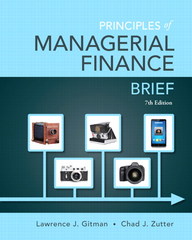Question
A valuer is making a pro-forma income statement and balance sheet. The profit has been forecast in the income statement based on the percent-of-sales method.
A valuer is making a pro-forma income statement and balance sheet.
The profit has been forecast in the income statement based on the percent-of-sales method.
Now the valuer is thinking about how that profit should affect the balance sheet.
Which of the below formulas correctly finds the new retained profits?
Select one:
a. RetainedProfitsNow = RetainedProfitsBefore + Profit + Dividends + Buybacks
b. RetainedProfitsNow = RetainedProfitsBefore + Profit - Dividends + Buybacks
c. RetainedProfitsNow = RetainedProfitsBefore + Profit - Dividends - Buybacks
d. RetainedProfitsNow = RetainedProfitsBefore - Profit + Dividends + Buybacks
e. RetainedProfitsNow = RetainedProfitsBefore - Profit - Dividends + Buybacks
Let the book value balance sheet be represented by these symbols:
A = L + OE
Let the market value balance sheet be represented by these symbols:
V = D + E
For a mature firm that that has been very successful in the past with a current market debt-to-assets ratio of 25% after impressive share price growth, which pair of the following amounts will be very close in value?
The pair of amounts that are closest in value will be:
Select one:
a. A and V, the book and market values of assets.
b. L and D, the book and market values of debt.
c. OE and E, the book and market values of equity.
d. A and E, the book value of assets and market value of equity.
e. L and E, the book value of debt and market value of equity.
A student is trying to find the market value of a firm's assets and is stuck at the step where they need to calculate the WACC.
The student is perplexed about how to find the debt-to-assets ratio needed in the WACC formula, when the value of assets is output by the valuation model but that same asset number is needed as an input into the valuation model.
Which of the below possible options is the WORST or least reasonable remedy to fix this circularity problem?
Select one:
a. Average similar firms' asset betas and input this into the CAPM required return formula to avoid the circularity problem.
b. Average similar firms' current book asset values.
c. Use MS Excel's Goal Seek or Solver algorithms to make the asset value used in the WACC formula the same as the asset value output by the valuation model.
d. Use multiples valuation based on current data so there's no need to discount any cash flows by the WACC, to avoid the circularity problem.
e. Sum the firm's current equity market value and book debt value assuming that the firm's stock are listed.
Step by Step Solution
There are 3 Steps involved in it
Step: 1

Get Instant Access to Expert-Tailored Solutions
See step-by-step solutions with expert insights and AI powered tools for academic success
Step: 2

Step: 3

Ace Your Homework with AI
Get the answers you need in no time with our AI-driven, step-by-step assistance
Get Started


